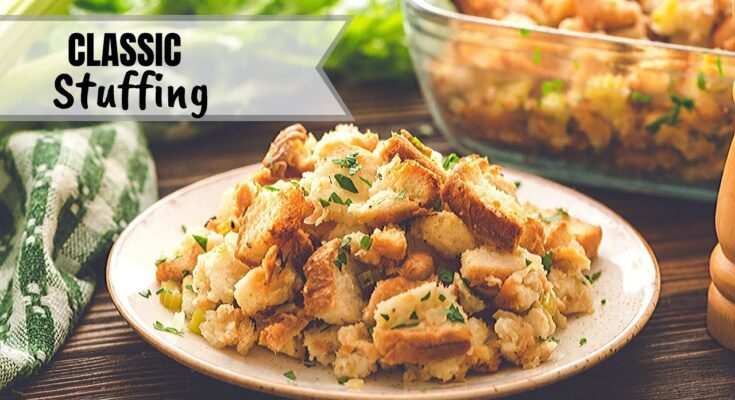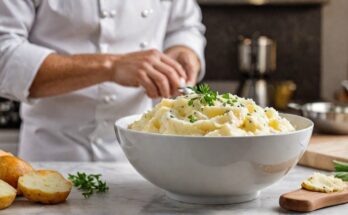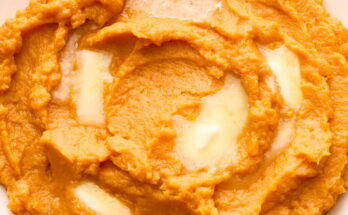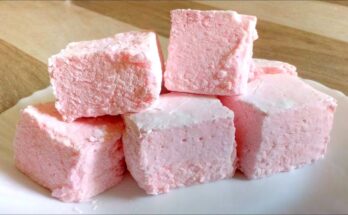Best Stuffing Recipe: Stuffing is one of the most beloved side dishes, especially during Thanksgiving and Christmas feasts. Its savory, herby flavors perfectly complement roasted turkey, ham, and other main courses. Whether you prefer a traditional bread stuffing or a modern twist featuring sausage, apples, or cranberries, this guide will walk you through creating the best stuffing recipe step-by-step.
What Is Stuffing?
Stuffing is a savory mixture typically made with bread, herbs, vegetables, and seasonings. It’s often used to “stuff” poultry, but it can also be baked separately as a side dish.
The History of Stuffing
Stuffing dates back to ancient times when people filled meats and poultry with grains, nuts, and spices to enhance flavor and texture. Its modern form has evolved into a flavorful bread-based dish.
Why Stuffing Is a Holiday Favorite
Stuffing has become a holiday staple because it pairs beautifully with turkey and absorbs the rich flavors of drippings, broth, and butter. It also allows for endless customizations, making it adaptable for all tastes and dietary preferences.
Ingredients for the Best Stuffing Recipe
Key Ingredients You’ll Need
- Bread Cubes – Choose a sturdy bread like sourdough, French bread, or cornbread.
- Butter – Adds richness and enhances flavor.
- Vegetables – Celery, onions, carrots, and garlic for depth and aroma.
- Herbs – Fresh parsley, sage, thyme, and rosemary.
- Broth – Chicken, turkey, or vegetable broth keeps the stuffing moist.
- Eggs – Helps bind the stuffing together.
- Seasonings – Salt, pepper, and optional spices like nutmeg or paprika.
Optional Add-Ons for Flavor Enhancement
- Sausage – Adds a savory, meaty element.
- Apples or Cranberries – Provide a sweet contrast to the savory flavors.
- Mushrooms – Offer earthiness and texture.
- Nuts (Pecans or Walnuts) – Add crunch.
- Cheese (Parmesan or Gruyère) – Adds richness and depth.
Tools and Equipment Required
- Large mixing bowls
- Sharp knife and cutting board
- Baking dish (9×13 inches)
- Large skillet or sauté pan
- Measuring cups and spoons
- Wooden spoon or spatula
- Foil for covering while baking
Step-by-Step Instructions for Making Stuffing
Step 1: Prepping the Ingredients
- Dice the Vegetables: Chop celery, onions, and carrots into small, even pieces for uniform cooking.
- Chop the Herbs: Mince fresh parsley, thyme, rosemary, and sage. Set aside.
- Cube the Bread: Cut the bread into ½-inch cubes. You can leave the crust on for added texture.
Step 2: Toasting the Bread Cubes
- Preheat your oven to 300°F (150°C).
- Spread the bread cubes on a baking sheet in a single layer.
- Bake for 15-20 minutes until dry and slightly golden. Stir halfway through for even toasting.
Step 3: Sautéing the Vegetables and Herbs
- Melt butter in a large skillet over medium heat.
- Add onions, celery, and carrots. Cook until softened (about 8-10 minutes).
- Stir in garlic and herbs, and cook for an additional 1-2 minutes until fragrant.
Step 4: Combining Ingredients
- In a large mixing bowl, combine toasted bread cubes and sautéed vegetables.
- Gradually add broth, stirring gently until the mixture is moistened but not soggy.
- Beat eggs in a separate bowl and mix them into the stuffing for binding.
Step 5: Baking the Stuffing
- Transfer the mixture to a greased baking dish.
- Cover with foil and bake at 350°F (175°C) for 30 minutes.
- Remove the foil and bake uncovered for another 15 minutes until the top is golden brown.
Stuffing Variations to Try
Stuffing is incredibly versatile, allowing you to experiment with flavors and ingredients. Here are a couple of popular variations:
Vegetarian Stuffing Recipe
- Ingredients: Replace chicken or turkey broth with vegetable broth and add mushrooms for a meaty texture.
- Additions: Dried cranberries, roasted chestnuts, or pecans for extra flavor.
- Flavor Boosters: Incorporate roasted garlic and caramelized onions for added depth.
Sausage and Apple Stuffing Recipe
- Ingredients: Use cooked Italian sausage for a savory twist and diced apples for a hint of sweetness.
- Seasoning Upgrade: Add fennel seeds, sage, and a pinch of cinnamon to complement the apples.
- Optional Add-Ons: Toss in dried cranberries or golden raisins for a burst of flavor.
Tips for Perfect Stuffing Every Time
Achieving the ideal stuffing—moist yet fluffy and full of flavor—requires attention to detail. Here are essential tips to keep in mind:
Avoiding a Soggy or Dry Texture
- Dry Bread Properly: Ensure the bread cubes are thoroughly dried or toasted to absorb moisture without becoming mushy.
- Add Broth Gradually: Pour broth slowly, mixing as you go, to achieve the right consistency—moist but not dripping.
- Cover While Baking: Bake covered for most of the time to retain moisture, then uncover to crisp up the top.
Balancing Seasonings
- Test Before Baking: Taste the mixture before adding eggs to adjust seasonings if necessary.
- Don’t Skimp on Herbs: Fresh herbs make all the difference in flavor—parsley, sage, thyme, and rosemary are essential.
- Spice It Up: Add nutmeg, paprika, or cayenne pepper for a subtle kick.
Serving Suggestions and Pairings
Stuffing pairs well with a variety of dishes, making it the star of your holiday table. Here are some suggestions:
- Main Courses: Serve alongside roasted turkey, baked ham, or prime rib.
- Vegetarian Pairings: Pair with stuffed acorn squash, roasted root vegetables, or mushroom gravy.
- Sauces and Gravy: Drizzle with turkey gravy or cranberry sauce for a burst of flavor.
- Leftover Ideas: Use stuffing as a filling for sandwiches, stuffed mushrooms, or breakfast casseroles.
How to Store and Reheat Leftover Stuffing
Storing Leftovers
- Refrigeration: Transfer cooled stuffing to an airtight container and refrigerate for up to 3-4 days.
- Freezing: Freeze portions in freezer-safe bags or containers for up to 2 months.
Reheating Instructions
- Oven: Preheat to 350°F (175°C). Add a splash of broth to prevent drying out and cover with foil. Bake for 20 minutes.
- Microwave: Heat in 1-minute intervals, stirring between each, until warmed through.
Common Mistakes to Avoid When Making Stuffing
- Not Drying the Bread Enough: If the bread is too soft, it can lead to a mushy texture. Always dry or toast the cubes.
- Overloading with Broth: Adding too much liquid at once can ruin the consistency. Pour slowly and check frequently.
- Skipping Herbs and Seasonings: Under-seasoned stuffing can be bland. Taste as you mix to ensure proper flavor balance.
- Overbaking: Overbaking can make stuffing dry. Keep it covered until the end and remove the foil only for crisping.
- Neglecting Mix-Ins: While traditional stuffing is great, experimenting with add-ons like sausage, apples, or nuts can elevate the dish.
FAQs about the Best Stuffing Recipe
1. What are the essential ingredients for making classic stuffing?
The classic stuffing recipe typically includes bread cubes, onions, celery, butter, and herbs like sage and thyme. You can also add chicken or vegetable broth to enhance moisture and flavor.
2. Can I make stuffing ahead of time?
Yes, you can prepare stuffing one day in advance. Keep it refrigerated in a covered container, and when ready to cook, bake it in the oven until it’s heated through and has a crispy top layer.
3. How do I make my stuffing moist but not soggy?
To avoid soggy stuffing, ensure that you do not add too much broth. Start with a moderate amount, and only add more if the mixture feels too dry. The bread should be moist but not swimming in liquid.
4. What variations can I make to the basic stuffing recipe?
There are many ways to customize stuffing. For a savory twist, add sausage, bacon, or mushrooms. For sweetness, consider apples, cranberries, or raisins. Nuts like pecans or walnuts add a nice crunch.
5. Is it safe to cook stuffing inside the turkey?
Cooking stuffing inside the turkey can be risky because the stuffing must reach an internal temperature of 165°F (74°C) to be safe to eat. To ensure safety, many cooks prefer to bake stuffing separately in a casserole dish.
6. How can I make stuffing vegetarian-friendly?
Substitute vegetable broth for chicken broth and skip any meat additions. You can also add more vegetables like carrots, leeks, and mushrooms to boost flavor and texture.
7. What’s the best way to reheat stuffing?
Reheat stuffing by covering it with foil and baking at 350°F (175°C) until warm throughout. For added crispness, remove the foil for the last few minutes of heating.
8. How long does cooked stuffing last in the fridge?
Cooked stuffing can be stored in the refrigerator for up to four days when kept in an airtight container. Make sure to reheat it thoroughly before serving.
Conclusion
Stuffing is more than just a holiday side dish—it’s a versatile, flavorful addition to any meal. By following this step-by-step guide, you’ll create a delicious, crowd-pleasing stuffing recipe that’s perfect for any occasion. From classic flavors to modern twists, there’s a stuffing recipe for everyone. So gather your ingredients, roll up your sleeves, and get ready to impress your guests with the best stuffing they’ve ever had!



